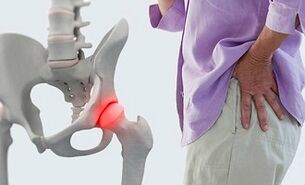
Our body is a complex system in which the breaking of one "screw" provokes the failure of another "part". In addition to diseases of the internal organs, chronic diseases of the musculoskeletal system, especially the joints, also cause many problems. Today I suggest to discuss arthrosis of the hip joint. What are the recommended symptoms and treatments.
This joint is the largest in the human skeleton. It is often used when walking, bending, bending, so that the disease brings severe pain and stiffness to movement. Fortunately, with early diagnosis, the disease can be treated well with medications. But it is not so easy to suspect that something is wrong, you need to know all the features of the disease and be able to know the first manifestations. And, of course, be careful to prevent it, and this will help our article.
Arthrosis or osteoarthritis of the hip joint is also called coxarthrosis, all of these terms mean one thing - a complex progressive disease with destruction of the cartilage lining the femoral head and acetabulum. As a result, the joints gradually collapse, turn into bones, grow too large and lose movement.
Coxarthrosis - what is it
Let us take a closer look at what coxarthrosis is, as this is a term often used by doctors due to the fact that recently the word "arthrosis" was removed from medical terminology, as it was previously believed that it had nothing to do with inflammation, butthen scientists proved otherwise. For us, this disagreement is not important, the main thing is that all these names refer to a very unpleasant disease.
Thus, coxarthrosis is a degenerative-dystrophic disease that provokes destruction and deformation of cartilage tissue. It is diagnosed mainly in women over 40, and in men - 60.
Why is it that injustice is done by women in front of them? The meaning here is the special structure of the female skeleton and the load on the hip joint, especially during childbirth and childbirth. As a result, middle-aged women are more likely to suffer from the disease; in the older age category, the number of patients of different sexes gradually equated.
Causes of hip joint arthrosis
The causes of the development of arthrosis in the hip joint can be many.
The most common are:
- heredity, if a parent or a relative has such a disease, then you need to be more concerned about your health, because even though the disease itself is not genetically related, the tendency to metabolic disorders and other disorders can cause joint problems;
- strong load on the pelvis, especially on athletes running, jumping, lifting weights;
- obesity, although a slight increase in weight can be negative for the joints, which causes an increase in load on them, therefore obese people are more prone to arthrosis;
- injuries, fractures, bruises on the pelvis;
- Endocrine disorders such as diabetes can cause bone problems;
- inflammatory processes, infections in the body, for example, purulent or rheumatoid arthritis;
- presence of problems in the spine or bones (flat feet, scoliosis, osteochondrosis) that alter posture and pressure on the joints;
- hormonal imbalance;
- weakens blood circulation in tissues;
- inactive lifestyle;
- old age, which is associated with deterioration of tissue nutrition.
Degree of Coxarthrosis
The doctor distinguishes 3 degrees or stages of the development of the disease, which will help distinguish the main symptoms. It is important to know that when making a diagnosis at stage 1, it is very possible to completely cure the disease and forget about it for many years, and in the third stage, the only accurate result is surgery, otherwise the patient is threatened with disability.
Level 1
The following symptoms will help ensure the presence of arthrosis in the 1st grade hip joint:
- pain during heavy load on joints and shortly thereafter;
- localization of pain only at bone junction area;
- walking style does not change;
- no defects;
- muscles maintain their strength and shape.
During computer diagnostics, doctors may notice bone growth on the joint surface, especially along the inside and outside of the acetabulum. At this stage, properly selected medications allow you to fully restore joint performance, but not all of us tend to run to the doctor at the first manifestation of pain.
Admittedly, a little discomfort often makes you think of stretching, dislocation, fatigue. We started rubbing the sore spot with different creams, ointments, we tried to cure them with folk methods, without understanding the cause and wasting valuable time. So, if you feel pain in your legs, the first thing to do is go to the doctor, spend some time for yourself - this is the key to a long, satisfying and happy life!
Level 2
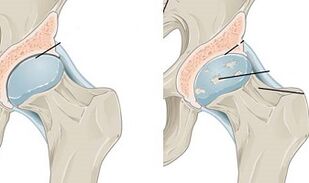
If the problem is not immediately diagnosed and cured, then grade 2 arthrosis is gradually formed, which is characterized by the following symptoms:
- more frequent pain that may appear even when inactive;
- pain is no longer limited to the area of bone connection, it radiates to the thighs, groin, buttocks;
- movement becomes limited, the person is unable to move his legs completely to the side;
- malfunction appears.
During the examination, the picture shows the growth of the bone at the edge of the cavity, the increase of the bone peak, the displacement and destruction of the edge.
Fortunately, with the help of complex therapy, 2nd degree arthrosis is still acceptable for conservative treatment.
Level 3
Well, this is very bad for patients who have neglected their health until they get stage III arthrosis, that is special for them:
- pain all the time, even without physical effort;
- need to use a cane or cane;
- atrophy, which is a shortening of a diseased leg muscle, a change in posture.
During the examination, the doctor noticed a lot of bone growth, increased bone marrow size, decreased joint space. Here there is only one way out - this is an operation to replace an obsolete joint with a specially made prosthesis.
Sign
We have briefly mentioned the symptoms of this disease, still summarizing all these symptoms.
Coxarthrosis manifests itself:
- severe pain in the joints, which can radiate to the legs, groin, knees;
- impaired movement, difficulty walking without support;
- shortens diseased limbs;
- poor posture;
- decreased range of motion at the affected joint;
- X-rays show muscle atrophy;
- MRI shows abnormalities in soft tissue, inflammation;
- CT indicates the presence of bone growth.
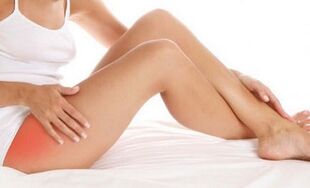
The symptoms are obvious, but not so simple. Therefore, with any of these symptoms, it is necessary to consult a specialist to get a diagnosis, as it can be arthrosis and other similar diseases with similar symptoms.
Diagnostics
The diagnosis of this disease should be made by more than one doctor, as pain in the pelvis can cause various diseases.
Like this:
- therapists can find chronic diseases that cause hip discomfort;
- a neurologist excludes or confirms the presence of an intervertebral hernia, sometimes they cause symptoms similar to those characterized by arthrosis;
- urologists examine men for inflammation of the prostate, the disease also often causes pain in the pelvis, radiating to the legs;
- gynecologists seek adhesion in patients, they are also similar to the manifestations of the disease;
- a rheumatologist is a narrow specialist who deals with such problems, he will help determine the stage of the disease, the cause and method of treatment;
- Surgeons and orthopedists will be very useful at a later stage when patients need surgery
Therefore, to make a correct diagnosis, it is not possible to limit ourselves to just one visit to the doctor, and besides, you still need to pass the test:
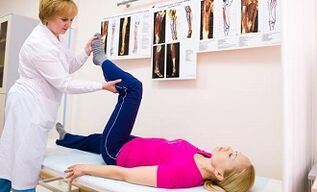
- clinical and biochemical analysis of urine and blood for inflammation in the body;
- MRI to examine soft tissue;
- CT for bone examination;
- x-rays will show bone damage;
- arthroscopy is indicated in some cases;
- pelvic organ ultrasound is sometimes required.
The success of treatment depends on the correct diagnosis, the degree of deterioration and the cause of the disability. For example, if osteoarthritis causes bone tuberculosis, then regular therapy is prohibited, and in the case of metabolic disorders, it is necessary to first eliminate the root cause, and then fight the consequences.
Treatment of hip joint arthrosis
The most effective treatment is at an early stage, so you can limit yourself to a variety of medications. How to treat inflammation - the doctor decides after several studies. Therapy is highly dependent on the cause and degree of destruction, but most of them seek to relieve pain, eliminate inflammation, improve blood circulation, for this they use:
- non-steroidal anti-inflammatory drugs;
- painkillers to return patients to normal life and facilitate walking;
- muscle relaxants to restore blood circulation in diseased areas of the body;
- chondroprotectors, which help stop cartilage tissue deformation;
- Steroid injections are used when the pain is increasing;
- medicine for vasodilation.
In addition to pills, injections and ointments, these treatments include the use of special diets and exercise therapy, a set of measures to help improve the condition and restore movement to the legs significantly.
Surgery
If conservative treatment does not bring visible results or the disease is diagnosed in the final stages, then there is only one way out - this is surgery. The procedure is complicated, in rare cases, rejection or risk of thromboembolism and other fatal complications is possible. At the same time, for patients who are seriously ill, this is the only opportunity for a normal life, because with artificial joints, after healing and recovery, one will be able to move calmly.
As with any surgery, a patient with coxarthrosis must first prepare for general anesthesia, he or she is not allowed to eat or drink before the procedure, and the bowel is cleared. Then his feet were wrapped in an elastic bandage to prevent edema, placed on his side and sunk into bed. Afterwards, the doctor makes an incision in the thigh, opens access to the joint, cuts the head of the femur bone, and inserts a pin into the incision, where the titanium head is attached.
Damaged pelvic bone tissue is also removed and replaced with a polymer pad to allow for normal leg movement in the future. Next, the wound is sewn, a bandage is applied on top. Upon recovery, the recovery period is still there, but if there is no rejection, a person can walk for 20 years, or even for the rest of his life, walking calmly with artificial joints, without feeling pain and stiffness.
Chondroprotectors
Due to this disease, the hip joint loses its movement, tissue changes, cartilage destruction and the formation of bone growth in place are observed. Fortunately, effective drugs have been invented to restore cartilage tissue, they are also called chondroprotectors, which in Latin means "cartilage protection".
So what can these drugs do?
- stops the process of destruction of cartilage tissue;
- speeds up metabolism in the joints;
- stimulates the production of synovial fluid, i. e. natural lubrication, which is normally produced in cartilage tissue and induces sliding of bone in joints;
- relieves inflammation;
- facilitates joint movement.
Preparations can contain two main components - glucosamine and chondroitin.
Depending on the form of the medicine, it can vary, from tablets, capsules, ointments, creams to injectable solutions. The choice of medication, dosage and duration of use should be determined by the attending physician, taking into account the characteristics of the organism. But, as a rule, injections are used during exacerbations, and then the patient is transferred to a milder treatment, which can last for months, at least six months. However, cartilage tissue recovery is a long process, but it does allow you to restore freedom of movement without surgery.
Injection
In some cases, treatment of the disease involves injections. Only a doctor can do that, using such a solution only in extreme cases, because it is risky to treat the disease in this way. The fact is that the gap between the bones in the hip joint is small, and with coxarthrosis it narrows. As a result, even experienced doctors are sometimes unable to get into the joint capsule itself, and the risk of touching nerves and blood vessels is enormous.
At the same time, injections are sometimes the only way to get rid of pain and inflammation, different medications are used for this purpose:
- corticosteroids for pain relief, such injections are allowed to be given no more than once every two weeks and a course of not more than 7;
- chondroprotectors help restore tissue, stimulate synovial fluid production for normal bone sliding, and increase tissue elasticity. In injectable form, the drug works faster than tablets or ointments, allowing the drug to be delivered directly to its destination;
- hyaluronic acid is the latest method to relieve inflammation and pain. It is used after all other drugs have been tried and did not get the desired results, the effect of its use is long lasting, injections are done once.
Physiotherapy
Unfortunately, in the fight against hip joint arthrosis, physiotherapeutic procedures are ineffective due to deep beds in the affected area. However, sometimes doctors prescribe kinesiototherapy to relieve pain.
Sort
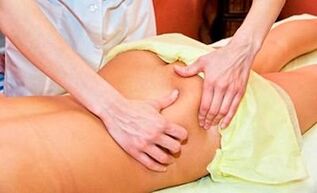
If a medical massage is performed by a professional, it helps improve blood circulation in the joints, restores mobility, and stops tissue destruction. But its use is indicated only exclusively during the period of remission, as long as there is no pain.
Also, to get a clear effect, you do not need to make a one-time visit to a specialist, but take a course two or three times a year to take care of the condition of the bones and joints.
Treatment of coxarthrosis with folk remedies
Although it is quite difficult to cure coxarthrosis completely in the hip joint using folk remedies exclusively, especially in severe and advanced forms, even doctors are aware of the effectiveness of natural remedies. Many formulations based on ingredients, roots and essential oils reduce the condition of a sick person, stop the destruction of cartilage and the formation of bone and scar tissue, stimulate the production of synovial fluid, which is very important in the fight against the disease.
For the most effective treatment and positive results, it is a good idea to discuss with your doctor what alternative methods you can use at home.
Some of the most popular gadgets:
- perestroot ointment. To prepare it, the roots must be crushed in a coffee grinder, mixed with melted lard in a ratio of 2: 3, boiled over low heat for five minutes, cooled and lubricated with the composition of the sore spot in the evening for a month. Then rest for a week and continue treatment;
- ointment with celandine - dry 7 plants, separate the leaves from the stems and grind, add 1 cup of olive oil, let cool for 14 days, after which the medicine will be like jelly, will melt in the hands. Smear the diseased area with nutrients every evening;
- birch leaves, linden flowers, dried parsley, cut, mix instead of tea and drink daily;
- wash lemon, cut and add 1 liter. boiling water, filtered after a few hours, add honey, drink three times a day;
- combine honey, iodine, ethyl alcohol and glycerin in equal amounts, insist 3-4 hours, lubricate the skin over the joints with a cotton swab 3 times a day;
- take 60 grams of saber root and elecampane, mix with 0. 5 liters. vodka, insist for a day in a dark, cool place, strain, drink 25-30 drops three times a day 30 minutes before meals, can also be used for rubbing.
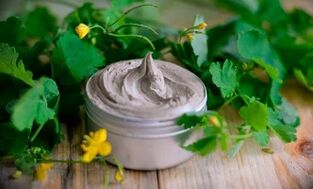
Exercises for coxarthrosis of the hip joint
Specially selected exercises will help improve the condition with coxarthrosis significantly, some will be recommended by a doctor. Before using it, you must consult your doctor, because with a complex that is not chosen correctly and there are contraindications, you can cause danger to your health.
For example, deformed arthrosis is dangerous to treat with physical activity - it is fraught with pain and tissue destruction.
Gymnastics is also prohibited when:
- increased disease;
- pain in movement;
- increase in body temperature;
- increased chronic disease;
- menstruation;
- hernia;
- heart and lung disease in severe form.
It is believed that therapeutic exercises for coxarthrosis should be aimed at restoring muscles and ligaments, but not loading weak joints, therefore, are not dynamic, but static movements are more appropriate. I am also happy that this exercise can be done at any right time, without spending a lot of money and joy on the way to a specialist, and given its effectiveness, it is only a crime not to use such universal medicine.
Here are some exercises:
- lie on your back, lift the affected leg 10-15 cm, freeze for 20-30 seconds, repeat for the other leg;
- performs the same movements, but quickly, holding the foot for only 1-2 seconds;
- to raise not a straight leg, but a leg bent at the knee at right angles;
- lie on your stomach, tear your feet off the floor and hold for a few seconds, slowly spread, reconnect, go down to the floor;
- lie on its side, bend the lower leg, and lift the upper leg and hold at an angle of about 45 degrees, wait 30 seconds, return to starting position, repeat for the other leg;
- do the previous exercises, but at the same time rotate the legs alternately in and out.
True, it is not recommended to practice only on training and video descriptions, it is better to discuss this with a doctor or even see a rehabilitation specialist several times, because in the event of another type of disease, it is necessary to adjust the complex to avoid complications.
Nutrition
Since osteoarthritis is highly dependent on metabolism, it is important to adhere to proper nutrition when treating the disease. It must be frequent, but not much. Excluded:
- salty foods;
- fat broth, mayonnaise, oil, dairy products (sour cream, cream);
- preservatives;
- toast from premium flour;
- smoking.

They should be replaced with more cartilaginous ones:
- dairy and low-fat dairy products, in particular, cheese are very important because they promote tissue regeneration and calcium absorption;
- lean fish and meat;
- beans, mushrooms, buckwheat, lentils rich in vegetable protein;
- Jelly meat, jelly fish, jelly, which contains collagen;
- carbohydrates from cereals;
- vegetables, fruits;
- complex carbohydrates (dried fruit, honey).
Drinking plenty of fluids is important to maintain salt balance.
Proper nutrition helps eliminate uric acid, which is harmful to joints, relieves inflammation, loses excess weight, edema, and thus reduces the burden on diseased areas and even restores cartilage tissue. The greatest effect can be achieved at stage 1 of the disease.
Prevention
If there are cases of illness in the family or if hip arthrosis already exists and is successfully treated, proper and regular prevention is important, which consists of the following:
- proper nutrition, which contains all the vitamins and minerals for normal metabolism in tissues;
- weight control to avoid extra load;
- Simplicity of physical activity, ability to move in such a way as to avoid injury and overuse in diseased joints;
- be careful with hypothermia, as it can make it worse. It is important to dress warmly, wrap the basin in cold weather, to avoid sitting on cold surfaces and staying in the draft;
- lead a healthy lifestyle, walk in the fresh air, gently strengthen the leg muscles.
Osteoarthritis is a very unpleasant disease, which, without proper treatment, with bone consolidation ends in disability and life in a wheelchair. Therefore, at the first symptom, see a doctor for diagnosis and help. Timely and thorough treatment allows you to get rid of problems and live without pain and restrictions.























